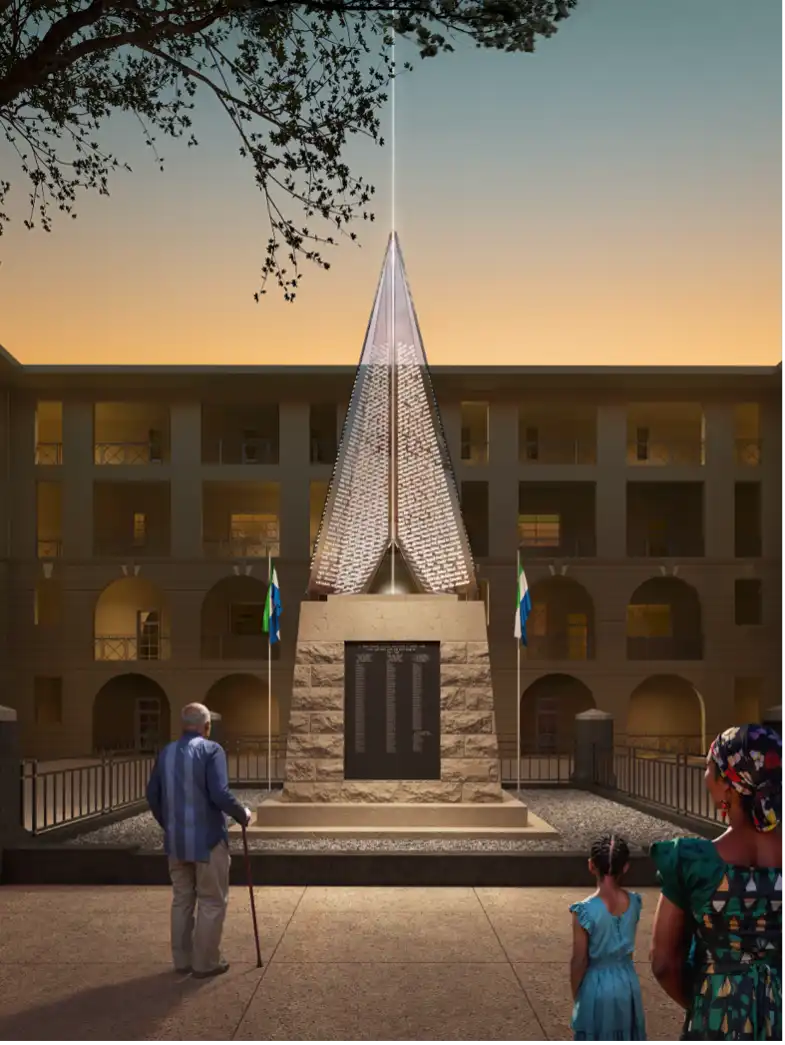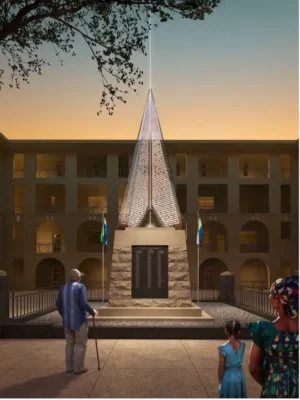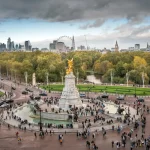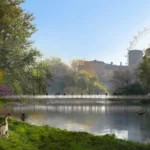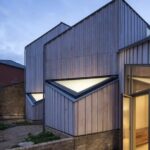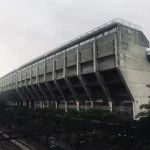New Commonwealth War Graves Memorial design, Sierra Leone WW1 Carrier Corps London monument image
New Commonwealth War Graves Memorial London
16 May 2025
Oshinowo Studio designs a new Commonwealth War Graves memorial to honour Sierra Leone’s WW1 Carrier Corps
New memorial design by Oshinowo Studio for Commonwealth War Graves Commission
Original Design: Edwin Lutyens architect
Design: Oshinowo Studio, Lagos, Nigeria
New Commonwealth War Graves Memorial for Sierra Leone Carrier Corps
A new memorial has been designed by Lagos-based Oshinowo Studio for the Commonwealth War Graves Commission (CWGC) honouring the fallen from the Sierra Leone Carrier Corps. The Freetown memorial will be the first CWGC site to integrate a beacon of light, which will shine a beam visible in the night sky from a 2.5km radius when lit.
During the First World War non-combatant labourers and soldiers from across Africa contributed to war campaigns. The Carrier Corps were the men who directly enabled the soldiers to fight and were enlisted to transport suppliers and materials of war across terrain that was impassable to vehicles and animals. Many of them died in service and have never been properly commemorated. Over recent years, the CWGC has been working with local partners to find out who these men were and ensure that they have a fitting memorial.
Ushering in a new era
The new memorial design is a radical contemporary intervention in which a prism of structural glass rises above the existing monument designed by Sir Edwin Lutyens in 1930. Joining the ranks of celebrated architects who have set the tone for war memorials to date, practice founder Tosin Oshinowo, is the first woman and the first West African architect to design a memorial for the CWGC.
Reaching nine metres high, the memorial’s four structural glass blades are etched with the recorded names of the 946 fallen Carrier Corps – an eloquent tribute and powerful symbol of remembrance. The memorial will form a focal point of World War commemoration and in line with the wishes of the City of Freetown be part of wider societal commemorations for significant anniversaries and festivals.
The studio’s response was to use light alongside glass. The integrated beacon will be lit in recognition of November’s Remembrance Day which recalls the end of the First World War and honours members of the armed forces who died in the line of duty, and for other significant days of commemoration in Sierra Leone.
Regarded locally as Sierra Leone’s National Memorial, the Freetown memorial sits in a courtyard flanked by the Government Treasury buildings. The new design provides access to the monument beyond the 7m x 7m perimeter and is intended to be visible to residents and onlookers from across the whole city. Oshinowo’s design went beyond the CWGC brief to propose an erudite and poignant memorial befitting the local context, placing ownership back in the hands of local Sierra Leoneans.
Architect Tosin Oshinowo said “Honouring the past, shaping the future, our design for the Freetown memorial stands not only as a tribute to the fallen, those who lost their lives during the First World War, but as a symbol of Sierra Leoneans’ collective commemoration, representing cost of war and a people’s resilience, as well as the global commitment to peace for generations to come.”
A co-design process
The process of researching missing names involved extensive global archive work by the CWGC’s historians. This was complemented by on the ground consultation led by West African heritage consultants, who engaged with stakeholders to explore a largely forgotten period of history. This period of Sierra Leone’s history is under-recognised globally in narratives dealing with the First World War, with few photographs and limited archival records. The new memorial offers a form of redress, and creates a permanent home to honour the men, confronting past inequalities.
Beyond Freetown, the architectural response will include a broader community reach by creating four satellite sites in provinces where the Carrier Corps were enlisted from. Here, marker memorials will be designed in keeping with the Freetown Memorial, enabling the public to commemorate and honour those lost during the First World War from their communities. This represents a new approach for CWGC, incorporating a co-design process to determine the places, people and events being memorialised.
+++
Freetown memorial by Lutyens
The Freetown memorial
The existing Freetown memorial to servicemen, built in 1930 and designed by Edwin Lutyens, commemorates soldiers of the First World War and made way for the servicemen of the Second World War by removing the small mention of the men of the Carrier Corps.
Alongside Sir Herbert Baker, Sir Reginald Blomfield and later Charles Holden, Lutyens was the Commission’s first Principal Architects who established a clear visual identity for war cemeteries and memorials around the world. Lutyens, already a highly regarded and prominent British architect, best known today for the Cenotaph in London and an array of public buildings in India, laid the foundations for this iconic design approach to memorials.
Commonwealth War Graves Commission – CWGC
The Commonwealth War Graves Commission (CWGC) is a global leader in commemoration, with a mission to ensure that those who died in service, or because of conflict, are commemorated so that the human cost of war is remembered forever. Founded by Royal Charter in 1917, we work on behalf of the Governments of Australia, Canada, India, New Zealand, South Africa, and the United Kingdom to commemorate the 1.7 million men and women from the Commonwealth who lost their lives in the two World Wars. The cemeteries, memorials, graves, landscapes, and records in our care can be found at 23,000 locations and in more than 150 countries and territories. www.cwgc.org
Oshinowo Studio, Lagos, Nigeria
Oshinowo Studio is an architecture, urban and interior design practice formed in Lagos, Nigeria in 2013, founded by Tosin Oshinowo. With an extensive international portfolio which includes housing, culture and large-scale humanitarian projects, the studio’s ethos is rooted in the intersection of human-centred design, culture and climate. Established in West Africa and shaped by Yoruba culture, Oshinowo’s perspective on design calibrates regional approaches to global social and environmental challenges.
Tosin Oshinowo is a registered Architect in the Federal Republic of Nigeria and a member of the Royal Institute of British Architects. She is a 2025 Harvard University Loeb Fellow and the curator of the 2023 Sharjah Architecture Triennial (11 November 2023 – 10 March 2024), also participating in the 2025 19th Venice Architecture Biennale with her research project, An Alternative Urbanism: Self-organising Lagos Markets which received a special mention from the awards jury.
New Commonwealth War Graves Memorial London design images, London, images / information received 160525
Location: Westminster, London, England, UK
UK Capital City Memorial and Pavilion Designs
Queen Elizabeth II Memorial Competition designs
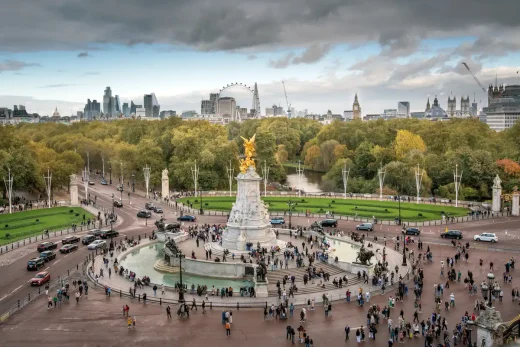
photo © Malcolm Reading Consultants/Emily Whitfield-Wicks
Grenfell Tower Memorial Competition Design Team
A design contest run by the Grenfell Tower Memorial Commission and the Royal Institute of British Architects:
Serpentine Pavilion 2024, Kensington Gardens, West London
Design: architect Minsuk Cho
Queen Elizabeth II Memorial Competition
West London Architectural Designs
1 Mayfair residential development
Architect: Robert A.M. Stern Architects
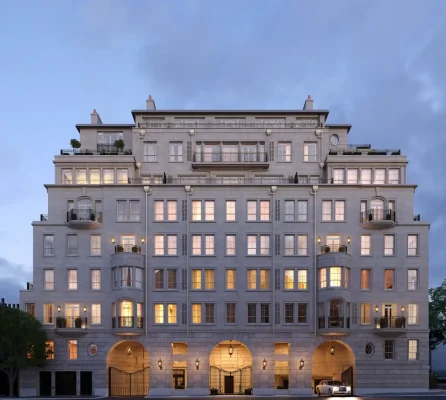
photo : Caudwell
New Zealand House building renewal, St. James’s
Renewal Architect: Lifschutz Davidson Sandilands
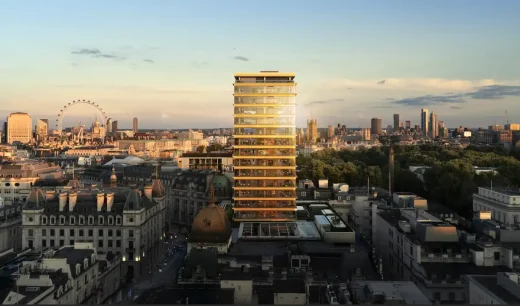
London Buildings
Contemporary London Architecture Designs
London Architecture Designs – chronological list
London Architectural Tours – tailored UK capital city walks by e-architect
Comments / photos for the New Commonwealth War Graves Memorial London design news page welcome.

